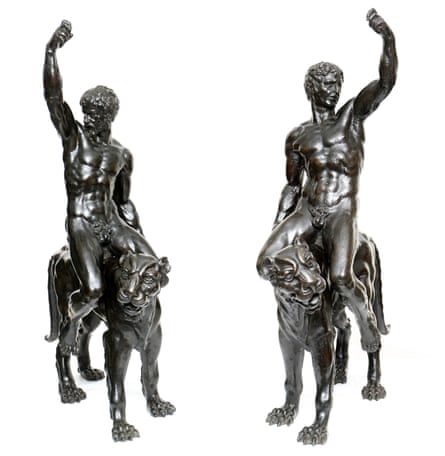A four-year research project that included painstaking examination of wonky toes, eight-pack abdomens, bulging thigh muscles and wavy pubic hair has helped to convince academics that Michelangelo is the maker of two works known as the Rothschild bronzes.
The Fitzwilliam Museum in Cambridge made a sensational claim in 2015 that Michelangelo was responsible for two privately owned bronzes depicting handsome, ripped, nude men riding panther-like creatures.
On Wednesday it released a mass of evidence proving, it said, that the attribution was correct and that Michelangelo should be as revered for his bronze work as he is for his marble carvings and fresco painting.
Peter Abrahams, a professor of clinical anatomy at Warwick Medical School, said there were accuracies and inaccuracies in the figures, the characteristics of which were repeatedly seen in works by Michelangelo but not other artists.

These included anatomically correct pubic hair, “rather curly, unruly and normal”, and feet that have a short big toe and a long second toe that points outwards, as you would see if the toes had a flip-flop strap between them. That conforms to the way Michelangelo almost aways carved, drew and painted toes.
Abrahams said all the evidence showed that Michelangelo must have dissected bodies and had an anatomical knowledge that was decades ahead of its time.
This knowledge can be seen in the “extraordinary” accuracy of the Rothschild bronze men, said Abrahams. For example, they have a thigh muscle, the sartorius, which is not visible but would be known to an anatomist. “He seems to be fascinated by it, it is a very pretty muscle.”
The figures also have perfectly placed “triangles of auscultation”, which is the small place in the human back where there is no muscle or bone, just skin and a small amount of fat. It is an anatomical detail that was not recorded until a generation after the bronzes were made, said Abrahams.
Then there is the fact that the figures have an eight-pack, an anatomical anomaly that again can be repeatedly seen in the work of Michelangelo and suggests that the male model he used had one.
Abrahams said the male figures were “slightly on steroids, they are pumped up, but if you were a guy lifting masonry stone all your life you would be like that.”
The multi-disciplinary research has been spearheaded by Dr Victoria Avery, the keeper of applied arts at the Fitzwilliam. She has uncovered compelling evidence that Michelangelo made bronze sculptures on a colossal scale, including a four-metre-high portrait statue of Pope Julius II, which was, heartbreakingly for the artist, melted down to become part of a cannon three years after it was made.
Apart from the Rothschild bronzes, no other Michelangelo bronze work survives. Avery said Michelangelo was the most significant and successful maker of bronze sculptures since antiquity, a part of his life overlooked or dismissed by art historians.
She added: “I knew him as a poet, as an architect, as a military engineer, as a marble carver, as a painter of frescoes, but nowhere was I ever taught about him as bronzista [bronze worker].
“I hope people will see Michelangelo as even more brilliant than before. We knew he was a genius but he can work with bronze as well.”
The research is published in a new book, Michelangelo: Sculptor in Bronze, described by Eike Schmidt, the director of the Uffizi in Florence, as “a game-changer” in Michelangelo studies.
